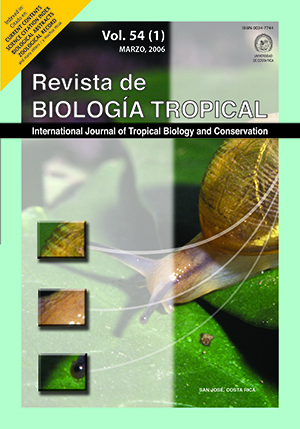Resumen
Se diagnosticó el estado de salud de tres arrecifes del Pacífico sur de Costa Rica, uno en Isla del Caño y dos en Golfo Dulce, y se determinó la densidad, la riqueza y la distribución de los macroperforadores no coloniales (> 1 mm) en fragmentos de coral vivos y muertos. Basándose en los indicadores tradicionales de degradación como alta materia particulada en suspensión y baja cobertura de coral, los arrecifes de Isla del Caño están en mejor condición que los de Golfo Dulce. La degradación en Golfo Dulce se debe principalmente a la gran cantidad de sedimentos terrestres generados por la deforestación de las cuencas de los ríos. En total se han reportado 36 especies de macroperforadores de coral, incluyendo este estudio, para el Pacífico oriental. A nivel de familia hay algo de endemismo (10%), y una mayor afinidad con el Indo-Pacífico (34%) que con el Atlántico oriental y el Mediterráneo (29%) y el Atlántico occidental y el Caribe (27%). Las familias de macroperforadores no coloniales más dominantes en los arrecifes estudiados son los bivalvos mitílidos, los poliquetos eunícidos y los sipuncúlidos aspidosifónidos. Los bivalvos son considerados los principales bioerosionadores internos debido a su gran tamaño y abundancia. El grado de mortalidad de las colonias coralinas y el nivel general de degradación arrecifal están relacionados con la composición de los macroperforadores no coloniales. La diversidad y la densidad total de macroperforadores, especialmente la densidad de aspidosifónidos es mayor en corales con una superficie muerta mayor que la viva. En colonias de coral con una superficie viva de más de 50%, la dominancia de mitílidos, la diversidad de los macroperforadores y la densidad total, son mayores en los arrecifes de Golfo Dulce que están más degradados. En colonias con más del 50% de mortalidad, la densidad total de macro-perforadores, especialmente aspidosifónidos, es mayor en el arrecife Platanillo de Isla del Caño, el arrecife más saludable de este estudio. La abundancia relativa de los bivalvos aumenta y la de los sipuncúlidos disminuye conforme aumenta la degradación arrecifal. En conclusión, la bioerosión interna se puede utilizar como un indicador de salud arrecifal.##plugins.facebook.comentarios##

Esta obra está bajo una licencia internacional Creative Commons Atribución 4.0.
Derechos de autor 2006 Revista de Biología Tropical
Descargas
Los datos de descargas todavía no están disponibles.


